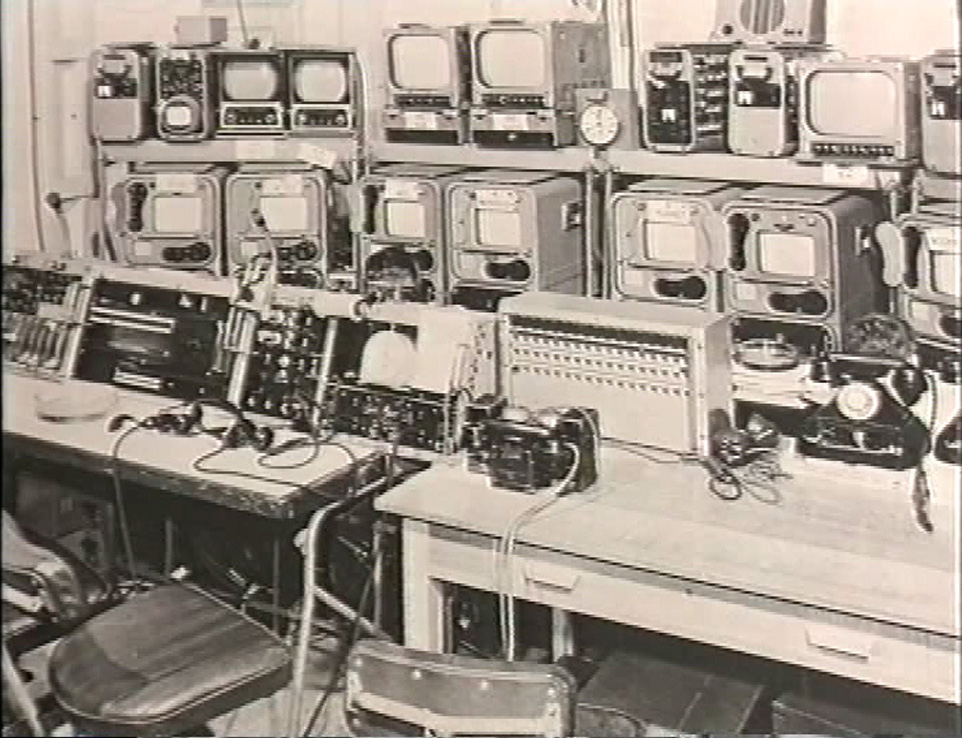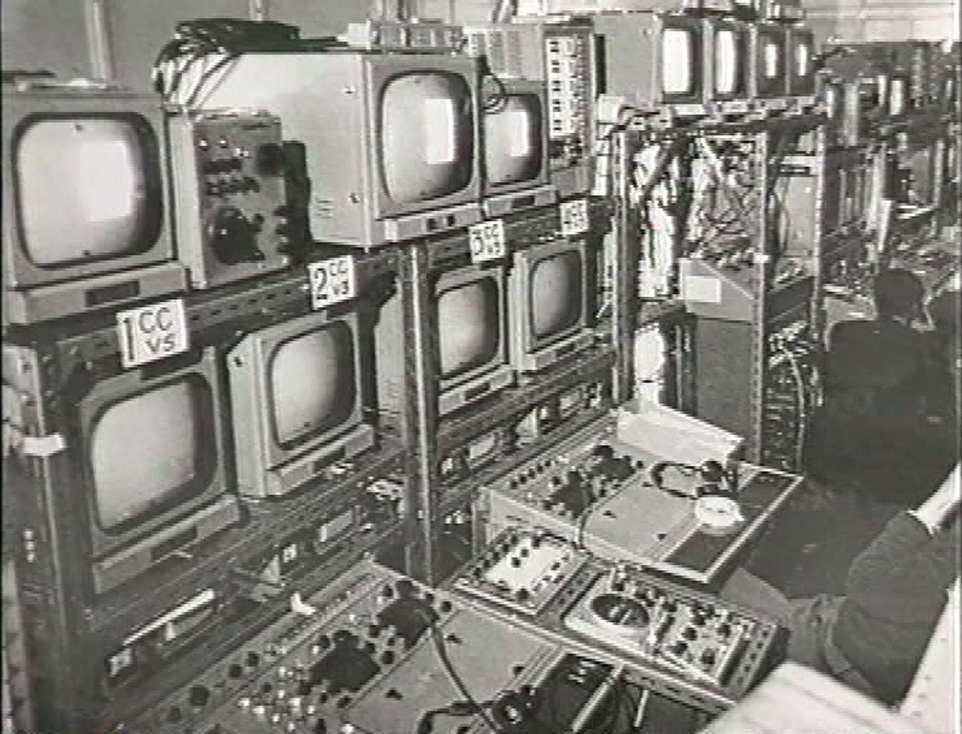Wimbledon 19??
John Howell (Hibou)
You OB chaps are so knowledgeable about your vehicles; can you tell me what year this photograph was taken? I hope that there is enough information in the picture for you to make a decision. No prizes but I hope it will provoke some lively discussion. I will reveal the answer [later!].
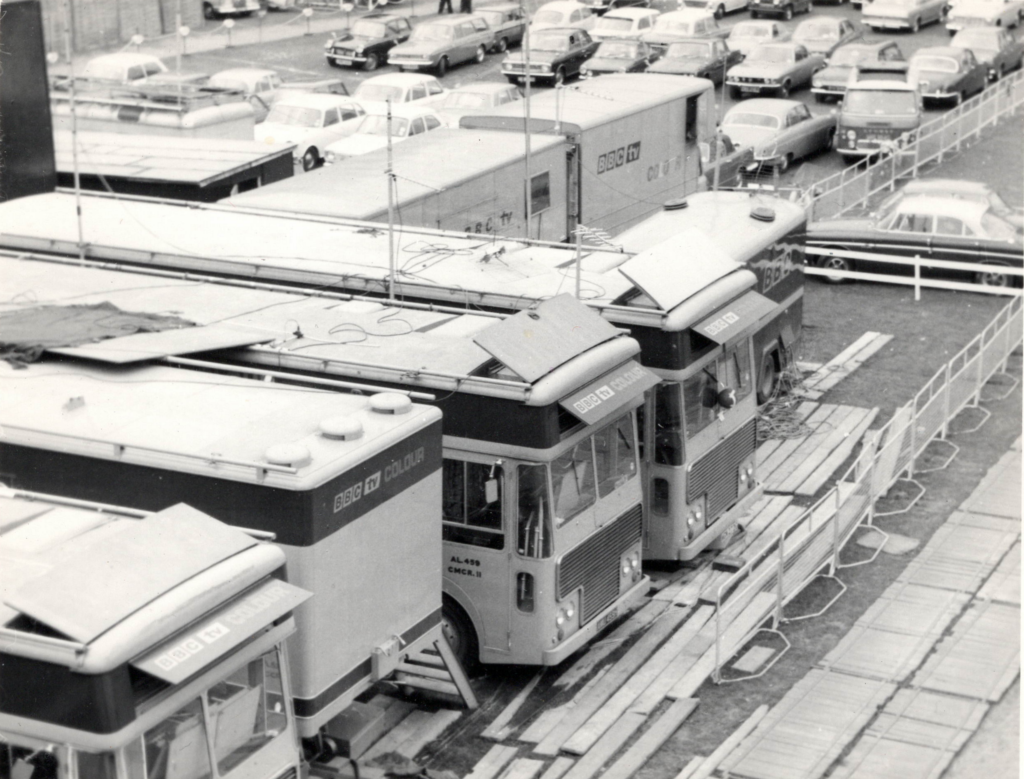
Alan Taylor
The best I can offer is a bid for mid 1970s. All the prominent scanners are Type II scanners.
There is a bit of an oddity in my OB career in that I rarely worked at Wimbledon, despite about 90% of the OB fleet and crews taking a three-week residency there every year. Therefore I can’t remember much about the parking arrangements which might offer further clues. I do remember that in those days there was usually a marquee nearby with an unofficial branch of the BBC bar. See, I remember the important stuff.
The reason I escaped Wimbledon was because during the mid to late 1970s I worked on “Seaside Special” and during the 1980s I mostly did drama.
I just re-read what John posted and see that he does know the date and was looking for guesses, so I would guess at 1975.
It was one of the few years I actually worked at Wimbledon, and I was the SA2 on LO 4. Leigh Osborne was the SA1.
Due to a run of consecutive programmes in the autumn we had been working away from home for a while and after finishing the Burleigh Horse Trials, we had just one night at home before going off on more shows. Both of our wives became pregnant that night and were due to give birth in early July. As it happened, Leigh’s wife gave birth on the Thursday of finals week and mine very late on Friday. Consequently neither of us were there for the de-rig and when our camera van returned to base, we had lost all our useful bits and pieces which we had acquired and built over the years. Leigh was fuming about it and for the next few months, he would take any opportunity to look for the camera vans of other units in base or on multi-scanner jobs and would go through all their ‘bits and bobs’ boxes to try and recover his treasures. He was very methodical and noted each unit in his diary as he scoured their camera van until he knew that he had rummaged through them all.
When we were at the Burleigh Horse Trials, like large events on country estates it become very congested afterwards. By the time we have gone off air and derigged, every road on the estate was gridlocked, as were the public roads outside of the estate. Ian Leiper had given me a lift and he was getting very impatient with the queues. I can’t remember what car he had, but it must have been something nice like a Volvo. He decided to drive over the fields of the estate and find an exit that way. The planning sheet included a detailed map of the estate, so we navigated a route to take us away from the obvious routes to the main roads. When we arrived at an exit, there was an NCP attendant who was stopping people pushing into the queue (countless others had the same idea). Ian got out of his car, spoke to the NCP guy who immediately held up the other cars and waved us through. Ian told him that we were vets rushing to assist a horse travelling in a horse box which had been injured and was in distress. I’ve met a few vets in my time and Ian couldn’t have looked more different to a typical vet, but fortunately his ruse worked perfectly, and I got home in time to add to my family.
Pat Heigham
What a wonderful Ian Leiper story!
I experienced similar congestion getting clear of Silverstone after the F1. However, for the French GP at Magny-Cours, the traffic police were brilliant, as they made several exit routes to be one-way, so there were extra lanes to feed out the traffic.
More on Mr. Leiper (I learned a lot about Grams under his tutelage) is here at http://tech-ops.co.uk/next/ationwid/
Guess I should call this Pat’s Tennis Memories:
I might have posed this question before, but does anyone remember the problem of extricating the BBC MCR from the ‘media’ centre garage when, due to weather the championships spilled over to a further Monday? It had been first in, so was blocked by everyone else.
My recollection was that the scanner was required to be in Sweden, shortly after Wimbledon.
I used to work for HBO, as a PSC unit, and I know that several ex-BBC types were busy for NBC.
It was a shame that the Club banished the trucks to an underground garage – it was charming in the old days when a media village was constructed outside the ground. A haven of hospitality!
Although I followed the tennis in the HBO crew room, it was galling that as soon as something exciting happened, we were dragged out to shoot an interview or Vox pop and missed the salient point.
I enjoyed the experience of meeting and interviewing the top players – Pete Sampras was a great chap, in no hurry to depart he stayed and chatted to us as we re-set for the next interview.
One scary bit – taken up on the Simon crane to full extent, one could not see the arm that was holding up the bucket – felt very unnerving!
But I’ve had my paws on both championship trophies – HBO wanted shots of them on a turntable.
At the Eastbourne Ladies Tournament, we were not allowed into the ground, so Nigel, my cameraman, knocked on the door of a house immediately opposite the venue, and asked to borrow their garden. $$ changed hands and they were delighted to host Sue Barker and the ladies as they were brought over in turn. Kept feeding us biscuits and tea!
The following link may be of interest:
Alan Taylor
As far as vehicle spotting [in the photograph] is concerned, the only obviously identified scanner is CMCR11, aka LO3. It isn’t sign-written as LO3 on the side of the cab, which suggests to me that the picture was taken before the LO(x) designations were introduced, which implies an earlier date than my previous guess. CMCR11 came into service in 1970, so that eliminates dates prior to that.
There are two other unidentified Type II scanners. The trailer with the steps down between the first two scanners is the CMCCR (Colour Mobile Central Control Room). I don’t know when it entered service, but it would have been needed once the OB fleet was colourised around 1970.

The CMCCR (Colour Mobile Central Control Room) had a massive production control room and a sound control room with comprehensive communications facilities. It was used to link up multiple scanners, taking vision and sound feeds from them. The racking of the cameras, vision mixing and audio sub-mixing was mostly done in those scanners. Boards have been put spanning the roof between Lo3 and the CMCCR. This would presumably have been to provide shade, or shelter from the rain for people going into the production area.
Beyond the last scanner is another older vehicle in the older green livery (dark grey for those of you viewing in B&W).
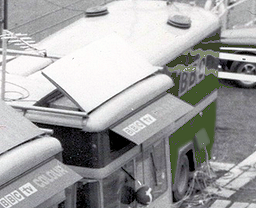
It doesn’t have teak strips on the roof or scaffold poles around it, so I don’t think it’s an old colourised scanner such as LO21. My guess is that it might be the FCV (foreign commentary vehicle, which was used to mix dozens of foreign commentators, who were sat in commentary boxes overlooking the courts. Obviously a commentary vehicle built in B&W days would still be useable for colour broadcasts, so that might explain the presence of an operational vehicle in the older livery.
Next to that, also at right angles are two VT trucks back-to-back.
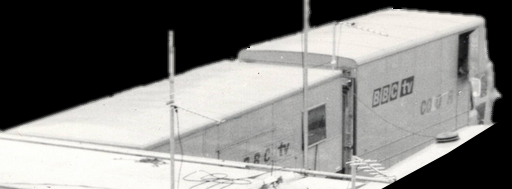
The black structure top left is the BBC’s temporary studio. Painted black in order to make it as hot and stuffy as possible during a hot summer.
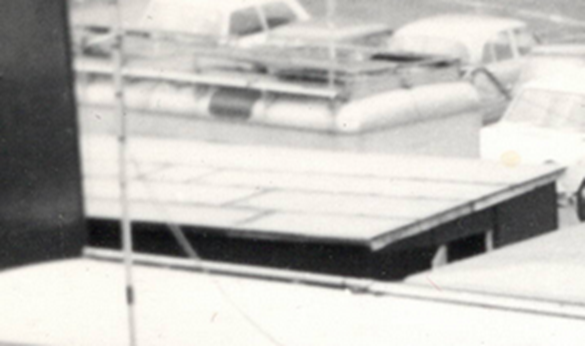
Air conditioning was minimal and noisy and was therefore had to be turned off whenever the red light came on. The studio lights chucked out loads of heat to add to the sauna effect. It wasn’t a good place to spend a lot of time in if the weather was hot.
Beyond the studio is the rounded roof of another van which looks to be unpainted and might have been left a natural aluminium colour. It probably isn’t a scanner. I would hazard a guess that it might be the support vehicle for the radio camera, or hand held cabled camera. It would have had an engineer working inside, racking the camera and trying to retain his sanity while John Pilblad ran around like a mad thing with the radio camera. There would have been a TA alongside the cameraman carrying the batteries, support equipment and radio transmitting gear.
I also spotted the Triumph Herald in the car park, I learned to drive in one. I can’t throw much light on the vintages of the other cars. Between the two Jags on the RHS is a badly parked, or manoeuvring, Commer van. It looks to be in the old green livery and was probably the runabout vehicle used to bring stuff from base to location if we didn’t have the right things on site.
One other oddity of Wimbledon was that the Kendal Avenue admin office set up a temporary office adjacent to the scanner compound (conveniently close to the temporary BBC bar) so that expenses claims could be dealt with in a timely manner. The ladies of the office also got to enjoy the sun, tennis and bar. For a while there used to be a meeting of the OB retired staff on a given day during Wimbledon fortnight. They would be sent temporary passes for the day, would meet at the bar and catch up with many of the people they used to work with. Inevitably progress ruined all that and modern security arrangements killed off any chance of continuing to do that.
Much of what I’ve written is guesswork and others might be able to correct errors and fill in loads of blanks. As I previously mentioned, I seldom worked at Wimbledon, so my recollections of it are vague and I never worked on the CMCCR in any capacity.
Hugh Sheppard
Hmmm! – about the FCV. As I recall, the original FCV 1 was a trailered control room probably built for the 1966 World Cup and operated at Wembley. Perhaps Malcolm Walker can say – as a bcc. (At Goodison Park, the Everton ground, we had an ‘orrible scratch assembly also for 20 commentators; dismantled afterwards and thankfully never seen again). FCV 2 was a smaller truck for 5 commentators, but a fading memory tells me that at Wimbledon both were usually de-rigged into an unlit basement area of the Centre Court for the 23 or 24 commentators in the 1970s and 1980s. Maybe power supplies and circuits still had to be routed via the FCVs when this picture was taken, with either or both FCVs otherwise empty at the time.
With the FCV’s replaced by an MICR (mobile international control room) in 1975, I would guess the picture preceded that, but only just.
Bernie Newnham
What I didn’t understand about those scanners is why they had to be a solid chunk. Why weren’t they articulated?
On my tiny trip to OBs we were at Hickstead, and the scanner was needed the next day a few miles away. When it wouldn’t start, they had to get a huge tow truck to move it, instead of just attaching another front.
Dave Plowman
Artics take up more space than a rigid vehicle. And have more of a traction problem on a poor surface?
Geoff Fletcher
Happened to me when Visions HD3 broke down on the way to Bolton Wanderers FC to cover Sky Footy in April 2006. Had to get a very large wrecker to rescue it and get it to site.
Geoff with the tow truck:
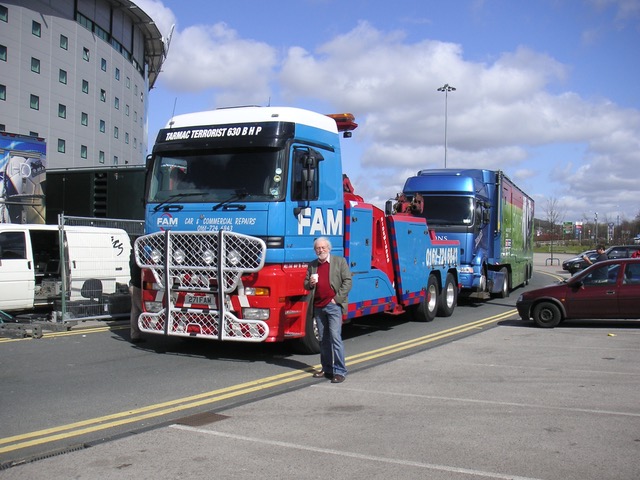
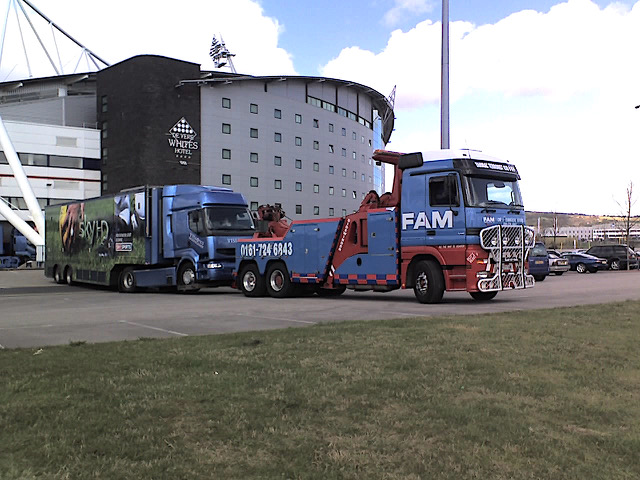
Geoff Fletcher
I found my OB Report for that Bolton match in my files. Here it is, for interest.
Visions Unit Managers were required to provide a written report to base Section Heads and our CEO asap after every OB.

Alan Taylor
Interesting that it was an artic. Any idea why they didn’t get a different tractor to drive it to site?
I don’t know much about these things, but assuming the tractor won’t start, wondering how you would remove it from the trailer in order to substitute another. Never thought about that before.
I think I still have a video I shot of a giant video screen trailer which had been used decoupled for a week while parked on grass. By the time the show was over, the front wheels had sunk into the grass by a few inches and they couldn’t drive the tractor back under. The driver decided that the only option was to reverse at speed and let kinetic energy do its thing, bouncing the trailer up a little when it made contact. Amazingly it worked, but it looked to be a very high-risk option.
Peter Fox
I have watched trailers being shunted for carriage on Red Funnel at Cowes. They have been deposited by hauliers who have left them in suitable bays alongside where the cars are lined up, so it provides entertainment while you wait.
Red Funnel use special tractors with all round visibility from a tiny cab.
The driver swings down and locks a pair of legs at the pivoting end of the trailer. He then winds the hand-crankable feet just enough to take the weight off the « fifth wheel ». A built-in jack in other words. These must surely be available on all trailers? Then he disconnects the air and electrical lines and drives the tractor away (or the opposite).
Takes just a few minutes to put a trailer on the ferry, jack it up and whizz back for the next one, saving space and presumably carriage costs. I think it mostly applies to regular operations like say Morrisons who can organize themselves to drop off and pick-up their trailers at either end in reasonable time without cluttering the port up.
Doesn’t answer the question about replacing a tractor except “Why not?”
Alan Taylor
Modern large scanners are mostly artics.
It was sometimes discussed, and the reason given was down to fire regulations and road traffic regs at the time. If doing a show at a West End theatre, it would be very convenient to unhitch an artic and park it close to other trucks so that you can pack more technology into that finite space. The fire people didn’t like the idea of vehicles parked up in a road without the means to drive away in an emergency.
It was also felt that when parked up in base, if there was a fire in the scanner hall, integrated vehicles could be evacuated quickly, while artics would in effect be immovable if the tractor wasn’t already hitched up.
I was also told that at the time, that the Type II scanners were the maximum allowable length, width and weight for normal vehicles. The cab wasn’t wasted space. Some equipment racks faced into the cab and the cab had rudimentary talkback facilities allowing it to be used for voice overs or operating a caption scanner.
One drawback with an artic is making good use of the space above the hitch. The floor has to be about five feet off the ground and if you’re going to have a working environment with sensible head clearance and space for cabling and ventilation ducts, the vehicle will need to be pretty high and would be unable to get into some venues. It’s also beneficial if the floors of all technical areas are on the same level, so you end up having a scanner with a floor which is high off the ground, usually with large storage lockers underneath. A floor which is five feet clear of the road also needs elaborate steps and platforms to climb up there. Even something as simple as access steps becomes tricky if you park on sloping ground, there is a high kerb or if there are obstructions such as parking meters or lamp posts. It was quite commonplace to park in a London street and not be able to open certain side lockers because parking meters blocked them. The riggers had to jiggle the exact parking position so that all the access doors were clear. They couldn’t always get it right for the side lockers too, therefore if anything might be needed out of the side lockers, it had to be taken out before the vehicle parked up.
Modern scanners have mostly opted for artics and expanding sides. On an older scanner, derigging essentially consisted of switching off the gear, unplugging the cables, making it tidy inside, stowing the chairs safe for travelling and then folding up the steps.
On modern scanners, you need to do all of those things, but the chairs can’t usually remain inside the expanding area once it’s been collapsed as there isn’t enough space. The internal partitions have to be folded up in an elaborate way, sections of the floor need to be lifted and the steps and platforms needs to be dismantled. In many cases, the entire derig of the OB is complete and back in the tender long before the scanner has been readied for travel.
There have been a few examples of scanners getting towed to site due to breakdowns. You can imagine how tricky it is to park a scanner in a confined space. Just imagine trying to do that with a tow truck and having to get the tow truck out too. It’s not as though you can put your shoulder to it and push it into place for the last few feet.
John Nottage
The first time I went to Wimbledon (after 1968), the main production area was built using the guts of a scanner which was derigged into a large wooden shed. This also contained Harry Carpenter’s studio. John Livingston organised it all for sound, with hundreds of cables, converters and odd tin boxes. Eventually, maybe because the new colour CMCCR arrived, we never needed to derig again. I assume this photo is after we’d stopped derigging.
I drove a white Triumph 2000 from 1973 to 1976. I think I can see it, or one like it in the car park. I did work a bit at Wimbledon in 1973, 1975 and 1976. Otherwise there aren’t many clues in the photo.
Alan Taylor
I well remember John Livingstone’s efforts at Wimbledon. He was a stickler for doing things the right way (some might say over-engineering, but it’s a matter of opinion) and he would use incredible amounts of equipment lashed together to get the results. He was still using OBA/8 equipment well into the 1970s. That gear was designed for use on radio OBs in the 1940s and used valves. One particular item was the Trap Valve. I’m not sure exactly why it was called that, but in modern terminology we would call it a DA. A big box, maybe 4u of 19” rack provided a four-way distribution amplifier and gave off loads of heat. We used towers of them. There were also similarly sized 4-way passive mixers with rotary faders, used for fine adjustment and mixing of feeds.
The number of XLR cables needed to patch everything together was insane. Camera vans normally carry boxes containing hundreds of cables of variable lengths and every available extra cable would have been withdrawn from stores, together with any cables that could be taken from any units remaining in base, having sacrificed their camera channels to be installed into the Wimbledon scanners. But we still always ran out of interconnecting cables, especially PO 316 jacks to XLRs which were needed for all that OBA/8 equipment which was built before XLRs were used.
Dave Plowman
Trap valve, I’d guess, means it allows a flow in one direction but not the other?
John Howell (Hibou)
I seem to remember that Pete Tolman the Radio mic king had a slightly unusual Triumph Herald, it was a two door ”estate” what we would nowadays call a Hatchback and it was mid-green. Could that be it top left?

John Nottage
I got Pete Tolman’s job after he was killed in a car crash with his wife (and child?). I seem to remember he was driving his Triumph which I’m sure was a 2-seater Spitfire. I got the job (SA1) in 1973, so Pete must have died 1972/73.
John Howell (Hibou)
I think all of you are on the right track, I can reveal that I took the picture on either 30th June or 1st July

I was on Sound Training Course No 12 and we got to mixing several matches. What I cannot reveal is where I was standing to get the shot. It must have been near the studio, we had just interviewed Evonne (Goolagong) Cawley, and you are right it was unbearably hot. Scan of pass attached.
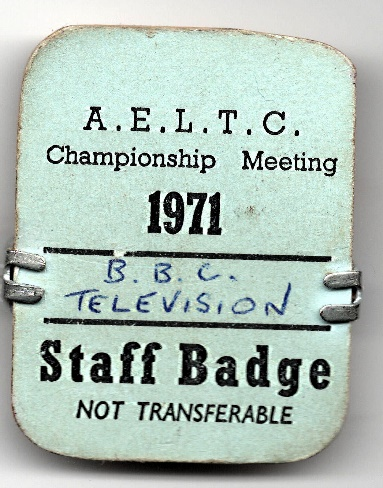
I’m not sure you could get two adults and a baby in a 2-seater Spitfire.
Please Note: The debate about Triumphs continues here…
Dave Mundy
My very first Wimbledon after joining OBs from TVC must have been in 1981-ish.
The vehicles were parked in a grassy area across the roadway from No.1 Court.
For the first time ever a large space had been made available under the audience seating and a Control Room was built in there by de-rigging the old CMCCR, rack by rack and bay by bay. The problem was that after the program ceased, we had to restore the truck to a working order to travel overnight to St. Andrews for the Open Golf! It was pouring with rain (of course!) but we made it and the next day we all travelled northwards! Next problem, no real ale in St. Andrews!
Mike Jordan
I’m not sure of my original source but a nice rig?
